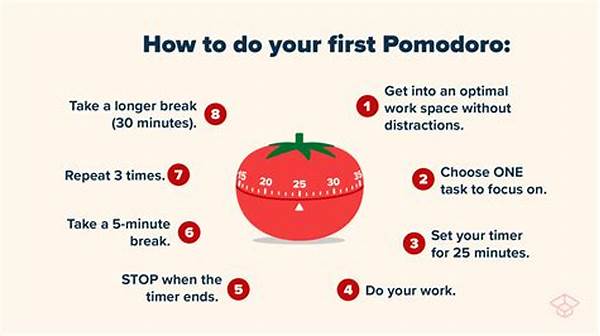In the hustle and bustle of student life, efficiency is often the key to achieving academic success. With countless methods and tools available to enhance productivity, one technique has consistently stood out – the Pomodoro Technique. Originated by Francesco Cirillo in the late 1980s, this time management tool has been the secret sauce for students and professionals alike, aiming to maximize focus and productivity while minimizing burnout. So, how exactly does the Pomodoro Technique turbocharge your study sessions? Let’s dive into this magical realm of ticking timers and productive sprints.
Read More : Tambakbet’s Morning Ritual For Optimal Learning Readiness
Imagine sitting at your desk with a mountain of textbooks and a bewildering list of tasks. Overwhelming, right? Enter the Pomodoro Technique – a simple, yet incredibly effective method to transform this chaos into a streamlined process. The crux lies in breaking work into intervals, traditionally 25 minutes in length, known as ‘Pomodoros’, followed by a short break. Research demonstrates that these focused bursts can significantly enhance concentration and minimize mental fatigue, thereby making study sessions more efficient and rewarding.
You might wonder how such a simple technique can revolutionize your study habits. The key lies in its ability to harness the power of time management. By compelling you to work within strict time frames, it combats procrastination and the allure of distractions. As a result, each Pomodoro not only sharpens your focus but also builds a sense of urgency and discipline. Indeed, the structured breaks, though seemingly counterintuitive, are pivotal. They refresh the mind, stave off burnout, and, interestingly, improve retention rates.
The Pomodoro Technique isn’t just a study tool; it’s your new productivity partner. Its relevance is underscored by countless testimonials and studies, which populate blogs, academic journals, and YouTube channels, all celebrating its efficacy. The secret to how Pomodoro Technique boosts study efficiency lies in its cyclical nature: study, break, repeat. By consistently applying these intervals, you pave the way for healthier work habits and a more organized approach to learning.
The Science Behind Pomodoro’s Effectiveness
—
Ever find yourself staring blankly at your study materials, struggling to absorb the information? It’s a common plight among students, yet one with a scientifically-backed solution. The Pomodoro Technique offers a unique and structured method to conquer academic fatigue and sluggishness. This technique, named after the Italian word for tomato, is as quirky as it is clever, taking inspiration from the tomato-shaped kitchen timer its inventor Francesco Cirillo used.
But does it really work? Numerous studies argue in favor of its efficacy. How the Pomodoro Technique boosts study efficiency can be traced back to its core principles of breaking down study periods and embedding regular intervals for relaxation. This not only keeps the brain engaged but also ensures a balance between rigor and rest. The ‘Pomodoro effect’ highlights a crucial message: less is more when it comes to focused studying.
One might argue its simplicity is its greatest asset. There’s no fancy software needed, just a timer, the will to focus, and the discipline to follow through. In an age where digital distractions run rampant, the Pomodoro Technique’s analogue roots offer a refreshing and effective counterbalance. It’s not just about studying harder, but smarter, aligning your study cycles with your brain’s natural tendencies for concentration.
Students from all walks of life have shared their experiences about the Pomodoro Technique’s transformative power. College forums and social media platforms are abuzz with stories of improved grades and diminished stress. The reason is clear: by implementing scheduled breaks, students find themselves more motivated and less overwhelmed, fostering a sustainable study routine.
These days, productivity is more than a buzzword; it’s a lifestyle. The Pomodoro Technique deftly combines traditional study practices with modern psychological insights, offering a blend of effectiveness and simplicity. Let’s delve deeper into its nuances and uncover the secrets behind how the Pomodoro Technique boosts study efficiency.
Unpacking the Pomodoro Method
The Psychological Edge of Breaking Study Time
—
- Enhance concentration and minimize distractions during study sessions.
- Mitigate the risk of burnout by incorporating regular breaks.
- Improve time management skills by creating a structured study environment.
- Increase motivation and productivity by using time-pressure to your advantage.
- Promote better information retention and comprehension through focused sessions.
- Foster a sustainable work-life balance by adopting disciplined study habits.
The Pomodoro Technique is more than just a productivity hack; it’s a comprehensive approach to transforming your study periods into efficient learning experiences. The foremost advantage is its impact on concentration – keeping distractions at bay while establishing a rhythm of steady progress. By structuring time into manageable chunks, it effectively enhances focus, a vital factor when dealing with demanding study materials or looming deadlines.
Additionally, the technique addresses the often-overlooked danger of academic burnout. By interspersing study sessions with generous breaks, it allows the brain ample time to refresh and recharge, significantly enhancing overall productivity. This method, therefore, acts as a preventive measure against fatigue, ensuring that learning remains both enjoyable and effective in the long run.
The efficiency of how Pomodoro Technique boosts study efficiency is tied to its simplicity and adaptability. Regardless of whether you’re a seasoned student or a novice embarking on a new academic journey, this technique molds itself to suit varying study needs and habits, encouraging a disciplined approach that balances study with life beyond textbooks.
Achieving Study Goals with the Pomodoro Technique
Practical Steps to Implementing Pomodoros
—
Studying may seem daunting, especially when faced with large quantities of information and impending deadlines. However, fear not, as the Pomodoro Technique is your trusty ally in this educational journey. How Pomodoro Technique boosts study efficiency is deeply rooted in its cyclical nature – periods of focused study followed by breaks. This pattern not only reduces perceived workload but significantly increases productivity.
The phases of the Pomodoro Technique induce a state of ‘flow’, a psychological concept where a person becomes fully immersed in an activity. This concentrated immersion facilitates deep understanding and retention of study material, all while promoting a systematic approach to learning. The brilliance here lies in the simplicity: by adhering to these cycles, students can tackle complex subjects with enhanced ease and efficacy.
A significant upside to this technique is its adaptability to individual study preferences. Whether you’re a night owl or an early bird, the Pomodoro Technique can be seamlessly integrated into any routine, making it a versatile study companion. The uniformity of its structure emboldens students to stay committed, with each Pomodoro ticking by as a testament to their dedication.
Student testimonials frequently highlight the transformative impact of the Pomodoro technique, often noting how their grades improved alongside their understanding of complex topics. By maintaining a consistent study pattern, they have reaped the benefits of better time management, while simultaneously reducing stress. Ultimately, it’s not just a study technique but a life skill that fosters a resilient mindset and constructive approach to challenges.
In conclusion, the Pomodoro Technique stands as a beacon of hope for students drowning in academic pressures. Its ingenious blend of focused study and mindful breaks unlocks potential previously hindered by poor time management and fatigue. With these insights, understanding how Pomodoro Technique boosts study efficiency becomes an exciting and enlightening journey.
Crafting Your Study Routine with Pomodoros
Personalizing the Technique for Maximum Benefit
—
- Visual representation of a typical Pomodoro cycle: 25 minutes study, 5 minutes break.
- A comparison chart illustrating time saved by using the Pomodoro Technique versus traditional study methods.
- A brain diagram showing areas activated by focused study versus those at rest during breaks.
- An infographic on common distractions and how they can be managed using the Pomodoro Technique.
- A timeline of a student’s day using the Pomodoro Technique versus a day without structured breaks.
The Pomodoro Technique is not just a method but a visual journey of productivity. Imagine a simple clock, ticking away, not as a countdown to stress, but as a motivator for unrelenting focus. This cycle is vividly captured in a chart – 25 minutes of pure concentration followed by a 5-minute oasis of relaxation. It’s simplicity at its finest, but profoundly transformative.
Now, consider a comparison between traditional study methods and the Pomodoro Technique. The Pomodoro approach stands tall, saving time and effort by boosting focus and maximizing productivity. This visual clarity underscores why many students and professionals alike swear by it, revealing how Pomodoro Technique boosts study efficiency in a manner that is both tangible and impactful.
Further enriching this visualization are insights into our brain’s activity during these cycles. Graphics depicting neural engagement during study sessions versus periods of rest are fascinating for those who appreciate the science of learning. They highlight an essential truth: our brains, much like muscles, require intervals of rest to perform optimally.
Finally, through infographics depicting common distractions, the Pomodoro Technique emerges as a shield against the external chaos. With each Pomodoro, users learn to guard their focus, turning potential disturbances into mere background noise. These illustrations collectively unveil a pathway to not just enhanced academic performance, but a more disciplined, fulfilled life.
—
The Pomodoro Technique isn’t just about measuring time; it’s about enhancing its quality. This simple yet profound approach fosters a learning environment teeming with focus and efficiency. By intertwining periods of intense concentration with breaks, it respects our cognitive limits and encourages sustainable study habits. Through vivid stories of success, testimonials, and proven outcomes, how the Pomodoro Technique boosts study efficiency becomes clear. It’s a manifesto for anyone aiming to turn study time from mere clock-watching into meaningful, productive learning, proving once again that sometimes, less truly is more.


